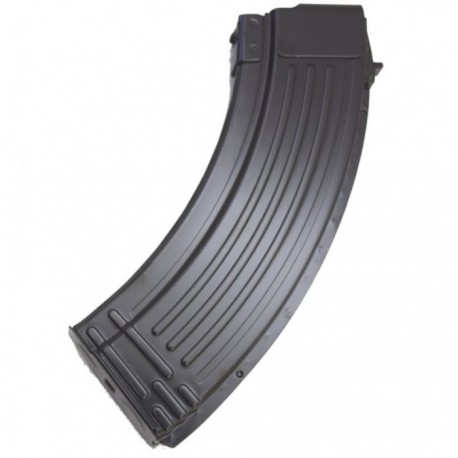The AK rifle has a well-deserved reputation for reliability. Making sure the weapon would fire upon demand under trying battlefield conditions, first time and every time, was one of the primary goals of the engineering team responsible for the design, development, and production of the AK-47. However, any rifle (or any machine for that matter) is only as reliable as its least dependable part. In the case of self-loading rifles, the device responsible for feeding ammunition to the breech mechanism is critical.
That part is called a magazine — not a clip, which in technical firearm terms is something different.
If the magazine assembly is faulty or poorly designed, the rifle cannot be relied upon to feed ammunition properly.
At the range or local plinking area, feeding malfunctions can be frustrating and lead to potentially dangerous conditions within the rifle. In a self-defense situation, they can cost you everything.

There’s a vast array of magazines available for the AK today. Capacities range from two- or three-round box magazines meant for hunting, to drums that will hold 75 rounds or more. Originally made from steel, they also can be found with bodies made entirely from synthetics (various types of plastic) or a mixture of synthetics plus steel reinforcing at critical points, such as the front and rear locking lugs and the feed lips.
Regardless of body type, all magazines are supplied with springs made of steel. Nobody to date has managed to come up with a strong, durable, reliable spring made of polymer.

By far the most ubiquitous AK magazines worldwide are the familiar, curved banana-type designed by the Soviets and issued to Warsaw Pact forces as standard military equipment. Each standard AK magazine holds 30 rounds of ammunition. Originally mass-produced by various manufacturers in Eastern Europe, the classic 30-round AK box magazine is robustly built of steel, almost bullet-proof and, like the AK itself, relentlessly reliable.
They are also heavy, anywhere from 11 to 14 ounces empty, depending on the maker. By way of comparison, a standard 30-round aluminum M16 magazine weighs in at about 4 ounces, empty. A steel AK magazine loaded with 30 rounds of military ball ammunition weighs close to 2 pounds, which is quite a load of ballast to add to your AK for casual shooting offhand.

By far the best are military surplus magazines. They were built with reliability and durability in mind, and for use under the most adverse conditions imaginable. You can find them from a variety of suppliers, in any condition, from old rust-buckets with dents and sometimes even bullet holes, to unissued as-new condition. Surplus military magazines in good condition are probably your safest bet, and come in steel and synthetic versions.
A tip: If you’re buying surplus, avoid magazines with dents. They can cause feeding problems. Rusty magazines are not desirable unless you like do-it-yourself cleanup and repair projects, assuming the rust is just a mild surface feature. Avoid magazines with deep pits or extensive damage inside and out.
Steel magazines can be found in many capacities, not just the 30-round variety. One of our personal favorites is the Hungarian 20-round steel magazine, though they are not easy to locate. (A good alternative is the 20-round Tanker from Bad Element). Commercial five- and 10-round steel magazines are out there as well, but can likewise be difficult to find and are considerably more expensive than the ex-military 30-rounders. For example the Russian surplus is the best but it is a bit more pricey.

One note regarding the purchase of surplus steel magazines.
As alluded to above, good quality surplus is a great option. However, the operative phrase is “good quality”. Demand for high quality surplus mags has skyrocketed but the supply has diminished. The issue with anything used is that there may be problems with some of them functioning properly.

The lesson is that it may be in your enlightened self interest to purchase new production steel magazines because it’s guaranteed that they will work, and if they don’t, you’ll get your money back or will be able to exchange them. This may not be the case with a used magazine. For new production steel magazines on a budget check out the Korean KCI Magazines. If you have a little more discretionary funds, the new production Romanian steel magazines are the best that you can buy.
Synthetic magazines have become increasingly common over the years, to the point where in the U.S. they are now at least as readily available as steel. Made by a variety of manufactures from a wide array of different types of plastic, they are lighter than steel, will not rust or dent, and can be had in a range of colors. Some of the best include the military surplus Soviet Bakelite-style, and Bulgarian “Circle 10” polymer magazines, both of which feature steel reinforcing at critical points.

The Circle 10, which I’ve had a chance to use, is utterly reliable and has almost no play or wobble once inserted in the magazine well. This brand is easily recognized by their logo, the number 10 stamped inside a circle and the magazine’s waffle-patterned body. Priced at around $45, they are not cheap but it’s a question of getting what you pay for.

Steel reinforcing is especially desirable in magazines that will see a lot of heavy use or will be employed for self-defense, because the steel helps ensure that the critical parts will be less prone to failure due to wear and physical abuse.

Synthetic magazines are also commonly encountered without steel reinforcing elements, but most regard such as only suitable for casual range or plinking use.
I have used such magazines as supplied by U.S. companies Tapco, U.S. Palm, Pro-Mag and Magpul, and all performed well.
Every nation that builds AKs also builds magazines exclusively for their rifles. Generally, any military-surplus magazine in 7.62×39 or 5.45×39 will work in any standard AK of the corresponding caliber. But as we have seen with other AK parts, there can be exceptions. You may well have to experiment a bit to find out if a particular type of magazine is acceptable to your AK and its unique pedigree.
Choosing a magazine
A candidate AK magazine should be tested for fit. Make sure that both the rifle and the magazine are unloaded, and that the rifle is on safe with the muzzle pointed in a safe direction. The magazine should slide in to the magazine well on the rifle with a firm feel. The front lug should engage the front of the magazine well easily.

Rocking the magazine back into place, there should be a solid click as the rear magazine latch on the rifle engages the magazine locking tab on the rear of the magazine. There should be no or very little wobble of the magazine from side to side, and none from front to back.There will be some slight variation in fit for magazines of the same model and manufacturer, but it will be slight.
If several examples of the same type of empty magazine won’t lock firmly into place as described, you’d better try another make of magazine for your AK.
Once you’ve determined that they fit, take your candidate magazines to the range with your rifle. Nothing will substitute for running each of the magazines in the rifle in live fire to make sure everything operates correctly and reliably.

If you do any research on the subject, you will find a wide range of opinion as to which magazines you should absolutely avoid purchasing. Yes, there are some real lemons out there. Some of them are even made by companies that manage to produce perfectly acceptable military magazines for other types of rifles, so be careful.
For example, many of the steel magazines made in South Korea are widely regarded as cheaply made and unreliable. Avoiding them might be a good idea.
Others report that they have had trouble with some makes of U.S. polymer magazines.
In the end, as with most things, you are best served by reading the various reviews and opinions and drawing your own conclusions.

And always do your own tests with a new magazine before you trust your well-being to it.
For our critical applications, we prefer to stick to magazines made by the same manufacturer as the rifle. It’s the safest bet.
Bolt-Hold-Open (BHO) Magazines
Anyone familiar with the AR platform knows that when you’ve expended your last round, the bolt remains open. It’s always nice to know you’re out of ammo, and for safety’s sake you can visually check whether there’s a round in the chamber.
A standard AK does not have this feature, but you can go to a gunsmith who will be able to engineer a bolt-open solution.
Marc Krebs of Krebs Custom suggests that although A BHO follower is good for range or target work, it’s not optimal in situations where magazine changes must be done quickly.
SGM Tactical, a company out of Knoxville, Tennessee, manufactures bolt-hold-open magazines in .308, 7.62 and 223. It is one of the few companies that makes gear specifically for the VEPR as well as other AKs. I’ve been using its 7.62 BHO mag for about a year with a Saiga, and it works perfectly. Price is $34.95.
Option B is to add a bolt-open-feature to your own magazine by installing a special follower.

A company called WeaponTech offers a drop-in replacement for standard AK47 metal and polymer magazines designed for 7.62×39.
WeaponTech is a venture between the inventor, Dimitri Mikroulis, and Primary Arms. Called the “WeaponTech BHO Follower,” you will need to disassemble your magazine to install it.
To do this, you take off the magazine’s floor plate, remove the spring, take out the original follower and add the new one designed by Dimitri. It’s not difficult — there are a number of videos that will show you how disassemble a magazine.
The main thing to watch out for is the spring inside the magazine. It’s under a lot of tension and it can pop out and impale your eye, if you’re not careful. Safety glasses are a good idea. Anyone who has taken apart a magazine will understand what I mean.
You can get a three-pack for $14.95. I think it’s a great product.
One last point to remember with a BHO magazine:
When you remove the magazine from the rifle, the bolt will snap shut, as it normally would after the firing cycle is complete.
I forgot that once and got a painful reminder as the bolt pinched my finger.